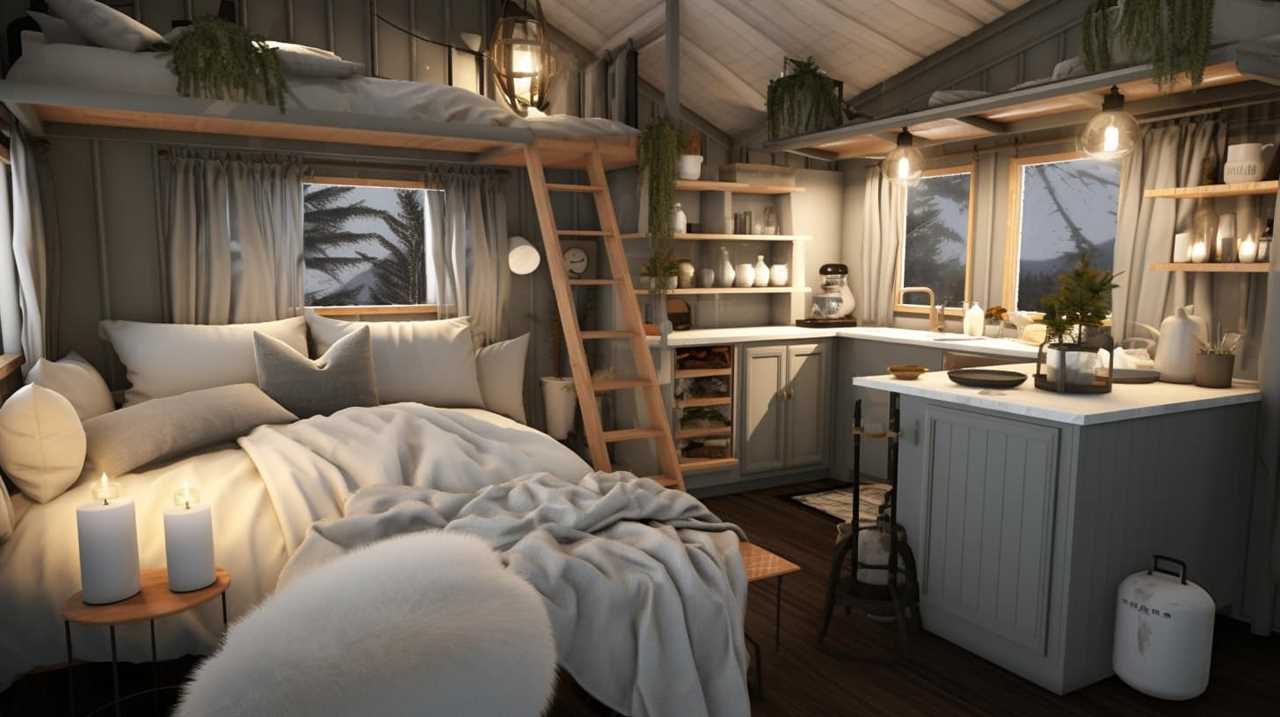Picture yourself in a charming home tucked away in the midst of nature, enveloped by trees and clear skies. A sanctuary that belongs solely to you, offering a cost-effective and comfortable living space. While it may seem like a far-off fantasy, with the correct tools and perseverance, it can transform into a tangible reality.
In this article, I will guide you through the process of finding cheap land for low income individuals who want to build their own tiny house.
Finding affordable land can be a challenging task, but there are various avenues to explore. From government programs and grants to affordable housing organizations and nonprofits, there are resources available to assist you in your search. Additionally, land auctions, foreclosure sales, and rural areas may offer more affordable options.
To navigate the complex world of real estate, it’s essential to connect with local experts such as real estate agents and landowners who can provide valuable insights. Furthermore, joining tiny house communities and forums can offer tips and advice from experienced individuals.
Don’t be afraid to think outside the box and explore unconventional land opportunities. Lease or rent-to-own options and partnering with others interested in tiny house living are also worth considering.
By following these steps and utilizing the available resources, you can find the perfect plot of land for your tiny house, making your dreams of affordable homeownership a reality.
Key Takeaways
- Explore government programs and grants for financial assistance
- Consider lease or rent-to-own options
- Connect with local real estate agents and landowners for insights
- Utilize online land listing platforms for convenient search
Research Available Government Programs and Grants
You’ll find a variety of government programs and grants available to research and potentially access for obtaining cheap land for your low-income tiny house project. These government grants can provide financial assistance and resources to help you secure affordable land for your tiny house.
Start by researching programs like the USDA Rural Development’s Single Family Housing Direct Home Loans, which offers low-income individuals the opportunity to purchase land with low-interest loans.
Additionally, the U.S. Department of Housing and Urban Development (HUD) offers various grants and programs aimed at promoting affordable housing. These grants can provide funding for land acquisition and development for low-income housing projects.
To further explore your options, consider reaching out to affordable housing organizations and nonprofits in your area. These organizations often have valuable resources and information about available grants and programs that can help you in your quest for cheap land.
Explore Affordable Housing Organizations and Nonprofits
If you’re interested in finding a bargain, there are several affordable housing organizations and nonprofits that can help you make the most of your limited resources. These organizations specialize in providing affordable housing options for low-income individuals, including those who want to build a tiny house. They can offer valuable resources and guidance on accessing affordable housing grants and programs that can help offset the costs of land acquisition and construction. Additionally, they may be connected to community land trusts, which are nonprofit organizations that acquire and hold land for the benefit of the community. These land trusts often have affordable housing initiatives and can provide opportunities for low-income individuals to purchase or lease land at reduced prices. By exploring these affordable housing organizations and nonprofits, you can find the support and resources needed to make your dream of building a tiny house a reality. In the next section, we will discuss how to look for land auctions and foreclosure sales to find affordable land options.
Look for Land Auctions and Foreclosure Sales
Take advantage of exciting opportunities to discover hidden gems and secure your own slice of paradise by exploring land auctions and foreclosure sales.
Land auctions and foreclosure sales can be a great way to find affordable land for your tiny house project. Many government programs, grants, affordable housing organizations, and nonprofits offer information and resources to help low-income individuals access these unconventional land opportunities. Real estate agents and landowners may also be able to provide leads on upcoming auctions and sales.
Additionally, online land listing platforms, tiny house communities, and forums can be valuable resources for finding out about available properties. Consider lease options, rent to own options, or partnering with others to make land ownership more feasible.
By exploring land auctions and foreclosure sales, you can find affordable land for your tiny house project and take a step towards realizing your dream of homeownership in rural areas.
Consider Purchasing Land in Rural Areas
Venturing into the countryside, you’ll unearth the perfect plot for your dream retreat, where nature’s symphony will serenade your soul. Buying land in remote areas can be an affordable option for those seeking cheap land for their tiny house. Not only are prices typically lower in rural areas, but you’ll also have more space to create the ideal tiny home oasis.
When considering alternative financing options, there are a few strategies to explore. First, look into owner financing, where the seller acts as the lender and allows you to make monthly payments directly to them. This can be a great way to bypass traditional bank loans and negotiate more flexible terms.
Another option is to explore grants or subsidies designed to assist low-income individuals in purchasing land for housing purposes.
In addition, connecting with local real estate agents and landowners can provide valuable insights and opportunities. They may have knowledge of upcoming land listings or be aware of properties that are not publicly advertised. By building relationships with these individuals, you can gain access to a wider range of options and increase your chances of finding the perfect affordable land for your tiny house.
Transitioning into the next section about connecting with local real estate agents and landowners, these professionals can offer guidance and expertise in navigating the buying process.
Connect with Local Real Estate Agents and Landowners
Immerse yourself in the local community and uncover hidden gems by connecting with real estate agents and landowners who hold the key to your dream retreat. By reaching out to these individuals, you can gain valuable insights into the local real estate market and find affordable land options that suit your needs. One way to connect with local landowners is to attend community events and network with people who have knowledge of available properties. Additionally, real estate agents can provide you with information on rent-to-own options, which can be a great solution for low-income individuals looking to build a tiny house. By establishing these connections and exploring the opportunities they present, you can find the perfect plot of land for your tiny home project. Next, let’s discuss how to utilize online land listing platforms to further expand your search.
Utilize Online Land Listing Platforms
One interesting statistic to evoke emotion in the audience is that online land listing platforms have helped thousands of people find their dream property for their tiny home projects. These platforms provide a convenient and accessible way to search for cheap land options that are suitable for low-income individuals who want to build their own tiny house.
Here are a few reasons why utilizing online land listing platforms can be beneficial:
-
Alternative financing: Many landowners on these platforms offer flexible financing options, making it easier for low-income individuals to purchase land for their tiny house projects.
-
Creative zoning: Online land listing platforms often have a wide range of properties available, including those in areas with more lenient zoning regulations. This allows individuals to find land where they can legally build and live in their tiny homes.
-
Expanded search options: These platforms allow users to filter their search based on specific criteria, such as price range, location, and land size. This makes it easier to find affordable land options that meet individual needs.
-
Increased visibility: By utilizing online land listing platforms, individuals can access a larger pool of potential properties. This increases the chances of finding a suitable and affordable piece of land for their tiny home project.
By utilizing online land listing platforms, individuals can take advantage of alternative financing options, creative zoning regulations, expanded search options, and increased visibility to find the perfect piece of land for their tiny home project. This is just one step towards achieving the goal of building an affordable and sustainable tiny home.
Join Tiny House Communities and Forums for Tips and Advice
Joining tiny house communities and forums is a great way to connect with like-minded individuals and gain valuable tips and advice for your own tiny home project. These communities and forums are filled with people who have already gone through the process of finding cheap land for their tiny homes and can provide guidance on finding land sharing opportunities. They can also offer insights into exploring tiny house financing options, such as grants, loans, or crowdfunding platforms specifically designed for tiny house projects.
By joining these communities and forums, you can tap into a wealth of knowledge and resources that can help you navigate the challenges of building a tiny home on a limited budget.
Transitioning into the next section, you can also investigate lease or rent-to-own options to further explore affordable housing solutions.
Investigate Lease or Rent-to-Own Options
After exploring tiny house communities and forums, I discovered another option for obtaining cheap land for low-income individuals like myself: lease or rent-to-own options. These alternatives provide an opportunity to secure land without a large upfront payment.
Leasing offers the advantage of lower monthly payments, allowing me to allocate more funds towards building my tiny house. Additionally, leasing provides flexibility, as I can choose to renew the lease or find a different location if needed. On the other hand, a rent-to-own agreement provides the potential to eventually own the land I’m leasing, giving me long-term stability.
To ensure a successful rent-to-own agreement, I’ll take a few important steps. Firstly, I’ll carefully review the terms and conditions of the agreement, including the purchase price and duration of the rental period. Secondly, I’ll save money for a down payment, as this’ll reduce the overall cost in the long run. Finally, I’ll consult with a real estate attorney to ensure the agreement is fair and protects my interests.
Transitioning into the next section, by partnering with others interested in tiny house living, we can explore more affordable options and share resources to make our dreams a reality.
Partner with Others Interested in Tiny House Living
By teaming up with like-minded individuals passionate about the minimalist lifestyle, we can discover more cost-effective alternatives and pool our resources for a shared journey towards realizing our tiny house dreams.
Partnering with others interested in tiny house living not only helps to reduce costs but also provides an opportunity for collaboration and support.
There are various partnering opportunities available that can help us secure cheap land for our tiny house projects. For example, we can form a cooperative where multiple individuals contribute funds towards purchasing a larger piece of land that can be subdivided into smaller plots for each tiny house.
Additionally, creative financing options such as crowdfunding or finding investors interested in supporting the tiny house movement can help us secure the necessary funds. By exploring these partnering opportunities and creative financing methods, we can significantly reduce the financial burden of acquiring land for our tiny homes.
Now, let’s think outside the box and explore unconventional land opportunities.
Think Outside the Box: Explore Unconventional Land Opportunities
Let’s get creative and uncover unique opportunities to find the perfect location for our dream tiny home! When it comes to alternative housing solutions, thinking outside the box is key. Here are three unconventional land opportunities to consider:
-
Community Land Trusts: These non-profit organizations purchase land and lease it to low-income individuals at affordable rates. By partnering with a community land trust, you can secure a long-term lease for your tiny home, ensuring stability and affordability.
-
Unused Urban Spaces: Look for vacant lots or underutilized spaces in urban areas. Many cities are open to leasing these spaces for tiny homes, providing an opportunity to live closer to amenities and job opportunities.
-
Creative Financing Options: Explore financing options that cater to low-income individuals. Programs like low-interest loans, grants, or crowdfunding campaigns can help make your dream of owning a tiny home a reality.
By exploring these alternative land opportunities and creative financing options, you can find affordable land for your tiny home and make your housing dreams come true.
Frequently Asked Questions
Are there any special grants or programs available specifically for low-income individuals looking to build a tiny house on cheap land?
Special grants and government programs, like those offered by affordable housing organizations, can assist low-income individuals in building their tiny homes on cheap land. Connecting with real estate agents and exploring land auctions and foreclosure sales are also viable options.
How can I find affordable housing organizations and nonprofits that can assist me in my search for cheap land for a tiny house?
I can find affordable housing resources and nonprofit assistance to help me in my search for a tiny house. These organizations provide valuable support and guidance to individuals looking for affordable housing options.
What should I know about land auctions and foreclosure sales in order to find the best deals on cheap land?
Land auction strategies and foreclosure sale tips can help me find the best deals on cheap land. I’ll research auction procedures, set a budget, and attend auctions prepared. I’ll also explore foreclosure listings and consider working with a real estate agent for expert guidance.
Are there any specific considerations I should keep in mind when purchasing land in rural areas for a tiny house?
When purchasing land in rural areas for a tiny house, there are important considerations to keep in mind. One key factor is zoning restrictions, which determine where and how you can build your tiny home.
How can I effectively connect with local real estate agents and landowners who may have cheap land available for sale?
To effectively connect with local real estate agents and find landowners with cheap land for sale, I suggest attending local real estate events, joining online forums and groups, networking with locals, and utilizing social media platforms to reach out and inquire about available properties.
Conclusion
After hours of diligent research and exploration, I’ve discovered a plethora of options for securing cheap land to build my dream tiny house.
From government programs and grants to affordable housing organizations, the possibilities are endless.
By connecting with local real estate agents and joining tiny house communities, I’ve gained invaluable tips and advice.
Additionally, considering unconventional land opportunities has opened up new doors.
With determination and resourcefulness, I’m confident that I’ll find the perfect plot of land to call my own and embark on my journey towards a simpler, more fulfilling life.
Hi, I’m Emma. I’m the Editor in Chief of Tiny House 43, a blog all about tiny houses. While tree houses are often associated with childhood, they can be the perfect adult retreat. They offer a cozy space to relax and unwind, surrounded by nature. And since they’re typically built on stilts or raised platforms, they offer stunning views that traditional homes simply can’t match. If you’re looking for a unique and romantic getaway, a tree house tiny house might just be the perfect option.
















